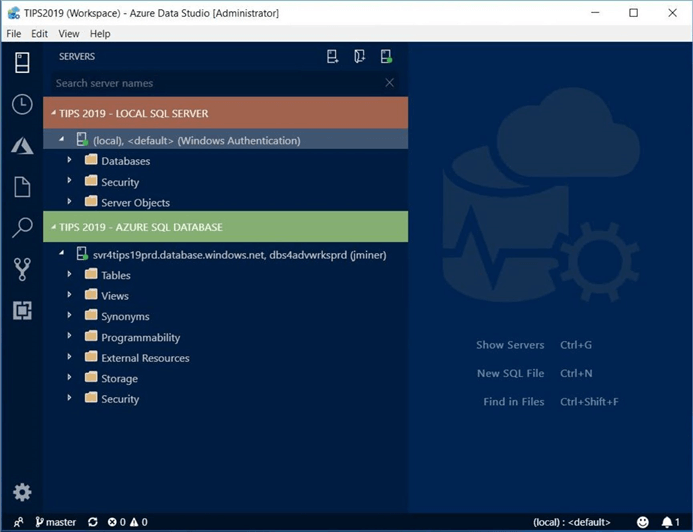

- #Azure data studio profiler install#
- #Azure data studio profiler code#
- #Azure data studio profiler windows#
Further, query events contain other important elements such as the client hostname, application name, login, Windows process ID, etc.

This capability is valuable when performance tuning since query events include discrete CPU and IO metrics as well as runtime parameters, which are key for troubleshooting query performance problems such as parameter sniffing. Share your favourite extensions in the comments below.SQL Server has always provided the ability to capture live queries on an ad hoc basis in an easily-consumable rowset format – first with legacy SQL Server Profiler, later via Extended Events in SSMS.
SQL Assessment (Microsoft) – evaluate the configuration of SQL Server for best practices using the SQL Assessment API. Plan Explorer (SentryOne) – get enhanced execution plan diagrams for queries inside Azure Data Studio. Redgate SQL Search (Redgate) – search for and within objects across multiple databases.  Redgate SQL Prompt (Redgate) – get access to snippets and powerful formatting options. Database Administration Tool Extensions for Windows (Microsoft) – get direct access to SSMS, including Properties and Generate Scripts. On my Windows development virtual machines I use all of the above extensions, as well as: whoisactive (Microsoft) – get dashboard insights based on the popular sp_WhoIsActive, written by Adam Machanic.
Redgate SQL Prompt (Redgate) – get access to snippets and powerful formatting options. Database Administration Tool Extensions for Windows (Microsoft) – get direct access to SSMS, including Properties and Generate Scripts. On my Windows development virtual machines I use all of the above extensions, as well as: whoisactive (Microsoft) – get dashboard insights based on the popular sp_WhoIsActive, written by Adam Machanic. #Azure data studio profiler code#
Visual Studio IntelliCode (Microsoft) – show recommended code completion tips based on context. SSMS Keymap (Kevin Cunnane) – use your favourite SSMS shortcuts in Azure Data Studio. sp_executesql to SQL (Pejman Nikram) – convert dynamic T-SQL to regular T-SQL for troubleshooting queries. SQL Server Schema Compare (Microsoft) – compare DACPAC files and databases, and apply changes. SQL Server Profiler (Microsoft) – trace queries, but don’t be fooled by the name: this actually uses Extended Events. SQL Server Import (Microsoft) – the Import Flat File Wizard from SSMS, but in Azure Data Studio. SQL Server Dacpac (Microsoft) – manage data-tier applications, working with DACPAC and BACPAC files. SQL Server Agent (Microsoft) – manage, configure and troubleshoot SQL Agent jobs. Server Reports (Microsoft) – get useful performance-related insights, including tempdb. Schema Visualization (Jens Hunt) – visualize database schemas in Azure Data Studio using mermaid.js. SandDance for Azure Data Studio (msrvida) – visually explore, understand, and present your data. Query History (Microsoft) – keep a record of past executed queries. PowerShell (Microsoft) – write and run PowerShell scripts with rich language support including syntax highlighting and IntelliSense. PostgreSQL (Microsoft) – connect, query, and manage Postgres databases with Azure Data Studio. Poor SQL Formatter (WSR Publishing, Inc) – use the popular Transact-SQL code formatter created by Tao Klerks. New Database (Kevin Cunnane) – add a “New Database” option when right-clicking on the Databases folder. MSSQL Db Insights (matticusau) – provide additional dashboard widgets to give you insight into your SQL Server instance. Machine Learning (Microsoft) – manage packages and models, make predictions, and create notebooks to run experiments for SQL databases. First Responders Kit (Drew Skwiers-Koballa) – work with the First Responder’s Kit from Brent Ozar Unlimited. Demo Mode (Drew Skwiers-Koballa) – toggle the editor font size between your font and a larger font size. Delete database (AlexP) – add a “Delete” option when right-clicking on a database. Data Virtualization (Microsoft) – support for Data Virtualization in SQL Server 2019 and higher, including Virtualize Data wizards.  Central Management Servers (Microsoft) – store a list of instances of SQL Server that is organized into one or more groups (more info here). Admin Pack for SQL Server (Microsoft) – a single package containing SQL Server Agent, SQL Server Profiler, SQL Server Import, and SQL Server Dacpac. Since I use a MacBook as my day-to-day computer, I am listing two sets of extensions, because some of them have dependencies on the underlying operating system. In most cases you can trust extensions from reputable publishers, but always take care.
Central Management Servers (Microsoft) – store a list of instances of SQL Server that is organized into one or more groups (more info here). Admin Pack for SQL Server (Microsoft) – a single package containing SQL Server Agent, SQL Server Profiler, SQL Server Import, and SQL Server Dacpac. Since I use a MacBook as my day-to-day computer, I am listing two sets of extensions, because some of them have dependencies on the underlying operating system. In most cases you can trust extensions from reputable publishers, but always take care. #Azure data studio profiler install#
For many of them you must visit a website, download the VSIX file and install it manually using the File > Install Extension from VSIX Package menu option. Note: not all extensions can be installed from the Extensions pane. Installing this many on SQL Server Management Studio (SSMS) would slow it down dramatically. It’s worth mentioning that for the most part Azure Data Studio extensions are extremely lightweight, both in download size and memory usage. At last week’s presentation to the Edmonton SQL Server user group, I spoke at length about the many extensions that are available for Azure Data Studio, and was asked by Chris Wood to share all the extensions I use.








 0 kommentar(er)
0 kommentar(er)
